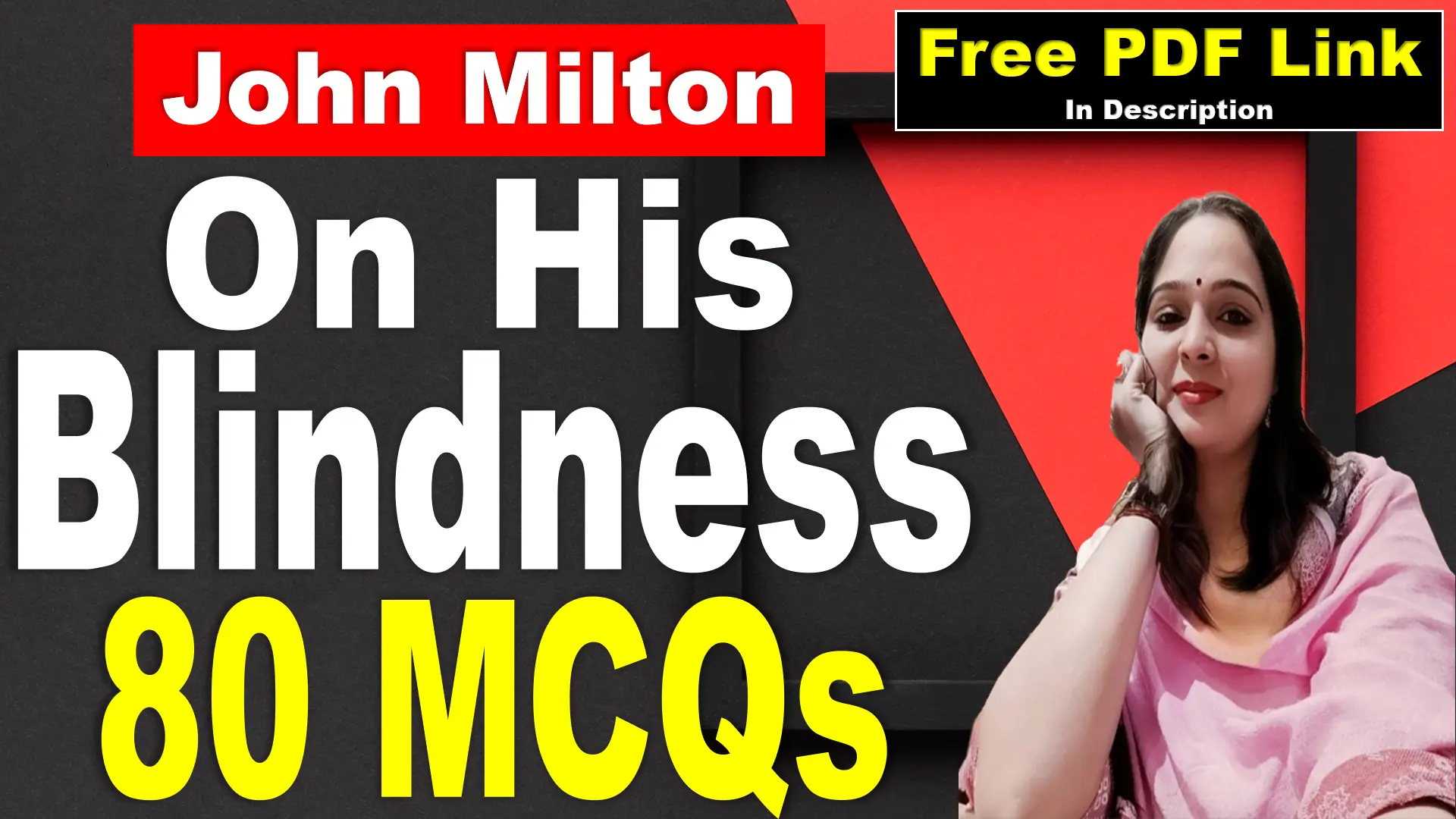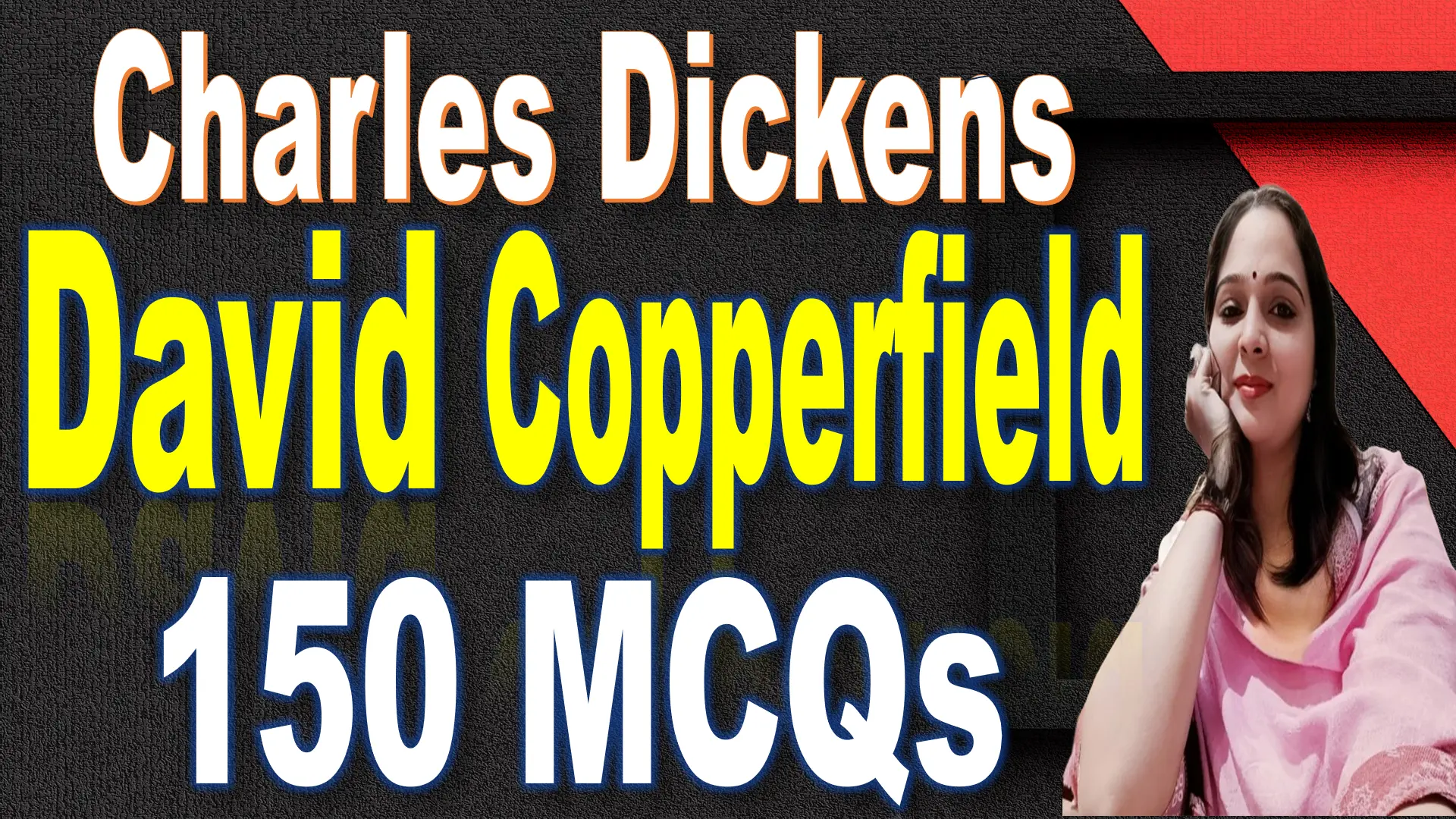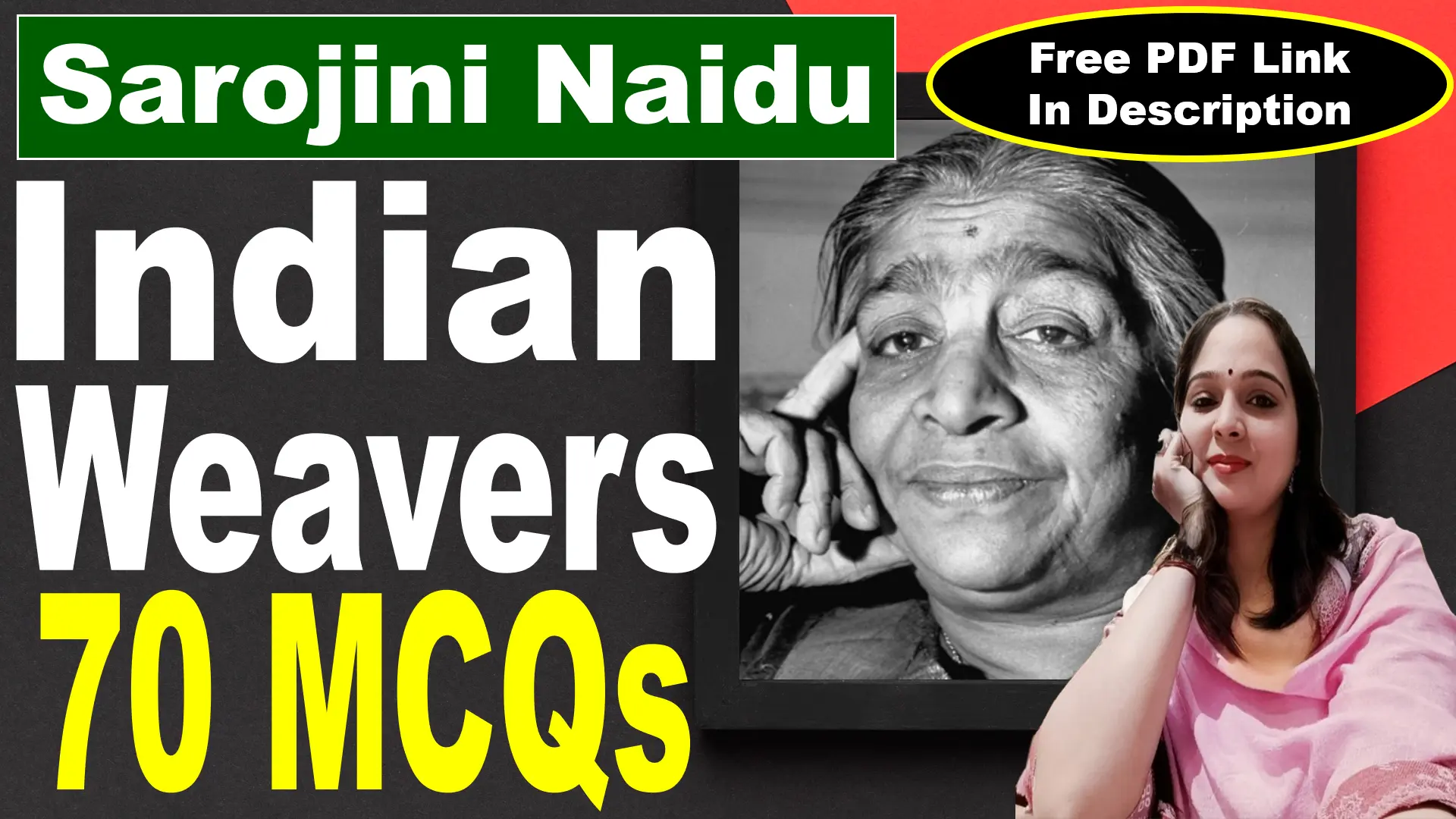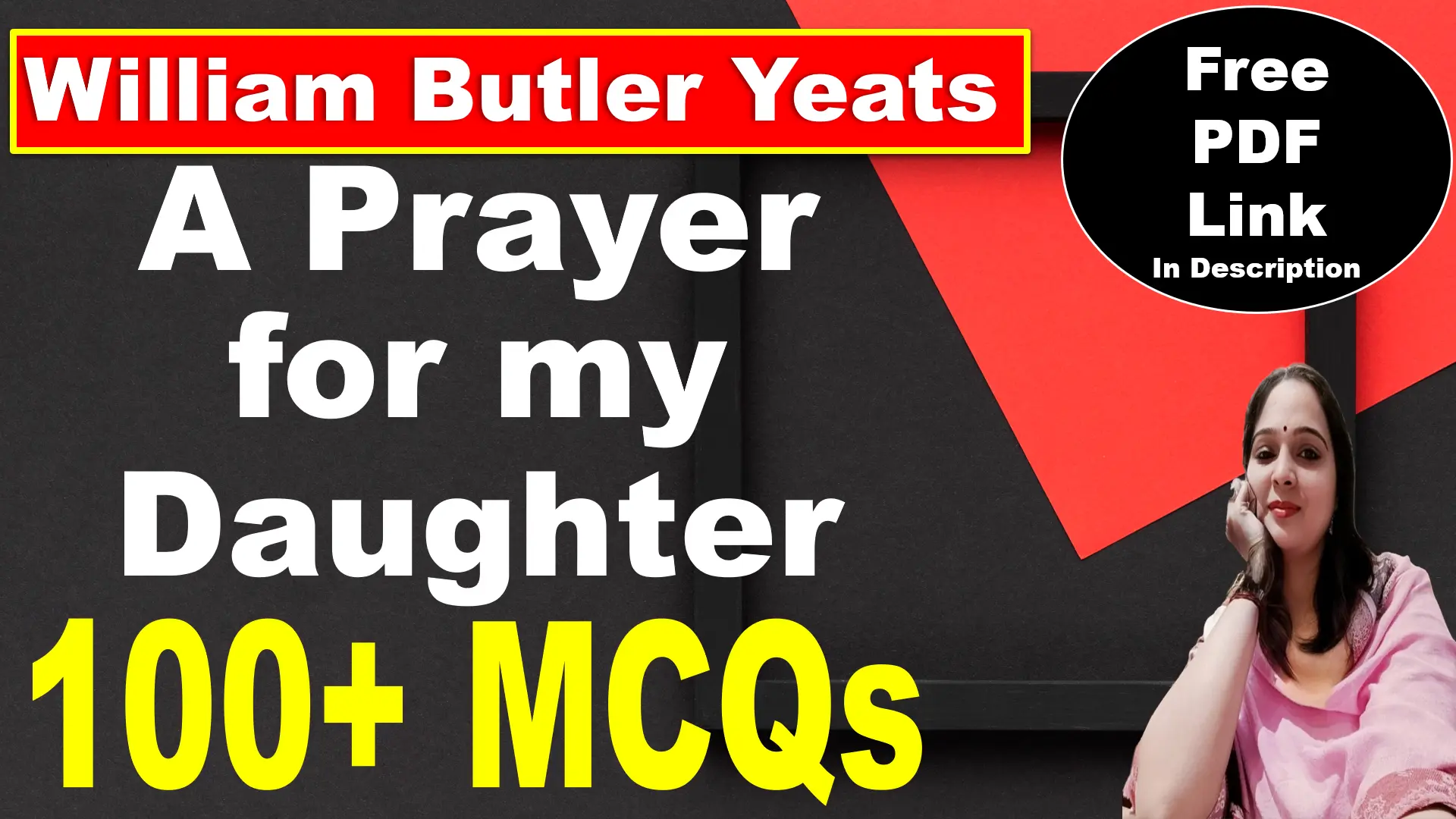
51. Which novel by Sudha Murty is a simple tale of human values?
a) Wise and Otherwise
b) Dollar Bahu
c) Gently Falls the Bakula
d) Both b and c
Answer: d) Both b and c
Explanation: Sudha Murty’s Dollar Bahu (2001) contrasts materialism and family values, while Gently Falls the Bakula (2008) explores ambition’s cost to love. Wise and Otherwise is non-fiction. Both novels use simple storytelling to highlight human virtues, aligning with Murty’s moral-driven style, making “d” the right answer.
52. Who is the author of the poetry collection The Unfinished Man?
a) Nissim Ezekiel
b) Dom Moraes
c) Keki N. Daruwalla
d) Gieve Patel
Answer: a) Nissim Ezekiel
Explanation: Nissim Ezekiel is one of India’s most prominent English-language poets. His collection The Unfinished Man (1960) explores themes of existentialism, identity, and the human condition in a rapidly changing world. Ezekiel’s poetry is known for its urban sensibility, dry humor, and intellectual rigor, addressing both personal and societal issues with introspection and wit.
53. Which novel by Chaman Nahal won the Sahitya Akademi Award and is set during the Partition?
a) Azadi
b) The English Queens
c) My True Faces
d) The Salt of Life
Answer: a) Azadi
Explanation: Chaman Nahal’s Azadi (1975), a Sahitya Akademi Award winner, vividly portrays a Hindu family’s exodus during the 1947 Partition.
54. Who wrote The Sea of Poppies, the first in the Ibis Trilogy?
a) Amitav Ghosh
b) Vikram Chandra
c) Arundhati Roy
d) Salman Rushdie
Answer: a) Amitav Ghosh
Explanation: Amitav Ghosh wrote The Sea of Poppies (2008), which is the first novel in his Ibis Trilogy. The novel is set during the First Opium War between Britain and China and explores the lives of a diverse group of characters who find themselves aboard a ship called the Ibis. The book examines themes of colonialism, opium trade, migration, and the social and cultural effects of imperialism.
55. Which poetess wrote My Story, an autobiography in English?
a) Kamala Das
b) Sarojini Naidu
c) Toru Dutt
d) Eunice de Souza
Answer: a) Kamala Das
Explanation: Kamala Das, one of India’s most important writers in English, authored her autobiography My Story (1976), which is considered a confessional work. The autobiography delves into her personal life, struggles with identity, love, and sexuality, and her reflections on societal norms. It broke new ground in Indian literature for its candidness and exploration of women’s desires and emotional needs, challenging the traditional constraints placed on women in Indian society.
56. Which novel by R.K. Narayan was adapted into a film starring Dev Anand?
a) The Guide
b) Swami and Friends
c) The Bachelor of Arts
d) The Dark Room
Answer: a) The Guide
Explanation: R.K. Narayan’s The Guide (1958) is a novel about Raju, a tour guide who transforms from a petty criminal into a spiritual guide. The novel, which explores themes of personal transformation, love, and redemption, was adapted into a popular Bollywood film in 1965 starring Dev Anand. The film was well-received and is still considered a classic in Indian cinema.
57. Who wrote Family Matters, a novel about a Parsi family in Bombay?
a) Rohinton Mistry
b) Bapsi Sidhwa
c) Firdaus Kanga
d) Thrity Umrigar
Answer: a) Rohinton Mistry
Explanation: Family Matters (2002) by Rohinton Mistry is a poignant and insightful novel that explores the life of a Parsi family living in Bombay. The novel centers around the aging father, Nariman, and his complex relationships with his children, who struggle with their own issues. Mistry’s novel is celebrated for its nuanced portrayal of family dynamics, Parsi identity, and the societal changes that affect the characters.
58. Which of these works is a poetry collection by Keki N. Daruwalla?
a) Under Orion
b) The Keeper of the Dead
c) Landscapes
d) All of the above
Answer: d) All of the above
Explanation: Keki N. Daruwalla’s Under Orion (1970), The Keeper of the Dead (1982, Sahitya Akademi winner), and Landscapes (1987) showcase his stark, evocative verse. His rugged style spans nature and human experience, making all three collections vital to his legacy, thus “d” is correct.
59. Who is the author of Cracking India (originally titled Ice-Candy-Man)?
a) Bapsi Sidhwa
b) Nayantara Sahgal
c) Kamala Markandaya
d) Anita Desai
Answer: a) Bapsi Sidhwa
Explanation: Cracking India (1988), originally titled Ice-Candy-Man, by Bapsi Sidhwa is a novel set against the backdrop of the Partition of India in 1947. The novel is narrated from the perspective of an 8-year-old girl named Lenny, who witnesses the devastating impact of Partition on her community. The novel is noted for its detailed portrayal of the trauma and divisions caused by Partition, as well as its exploration of themes such as violence, politics, and personal relationships.
60. Which novel by Aravind Adiga critiques the Indian education system?
a) The White Tiger
b) Between the Assassinations
c) Last Man in Tower
d) Selection Day
Answer: d) Selection Day
Explanation: Aravind Adiga’s Selection Day (2016) is a novel that critiques the Indian education system, especially in terms of its pressure on children to succeed and the societal obsession with competitive exams. The story follows two brothers, one of whom is a promising cricketer, as they navigate their aspirations and the harsh realities of the system. Adiga’s novel explores themes of family, ambition, and the impact of societal expectations on youth.
61. Which novel by Mulk Raj Anand portrays the struggles of a laborer in colonial India?
a) Coolie
b) Two Leaves and a Bud
c) The Old Woman and the Cow
d) Both a and b
Answer: d) Both a and b
Explanation: “Coolie”: This novel, published in 1936, focuses on the plight of a young boy named Munoo, who becomes a “coolie” (laborer) in British-ruled India, highlighting the exploitation and hardship faced by the working class.
“Two Leaves and a Bud”: Published in 1937, this novel explores the exploitation of laborers in the tea plantations of Assam, depicting the suffering and struggles of the marginalized under colonial rule.
“The Old Woman and the Cow”: While also a work by Mulk Raj Anand, this novel does not primarily focus on the struggles of laborers in colonial India, so it is not the correct answer.
62. Who wrote the novel The Romantics, exploring love and identity in India?
a) Pankaj Mishra
b) Vikram Seth
c) Amitav Ghosh
d) Rohinton Mistry
Answer: a) Pankaj Mishra
Explanation: Pankaj Mishra’s The Romantics (1999) follows Samar, a young man in Benares, navigating love and self-discovery amid cultural shifts.
63. Which novel by Salman Rushdie blends mythology with modern India?
a) The Moor’s Last Sigh
b) Shalimar the Clown
c) The Ground Beneath Her Feet
d) Fury
Answer: c) The Ground Beneath Her Feet
Explanation: Published in 1999, The Ground Beneath Her Feet by Salman Rushdie blends mythology—most notably the Greek myth of Orpheus and Eurydice—with the vibrancy and complexities of modern India. The novel intertwines a rock-and-roll love story with rich mythological undertones, set against a backdrop that spans India and the global music scene. While Rushdie’s other works like The Moor’s Last Sigh and Shalimar the Clown also explore Indian themes, they don’t emphasize mythological blending to the same extent. Fury, meanwhile, is more focused on contemporary urban life without a strong mythological thread.
64. Which novel by Raja Rao explores the philosophical conflict between East and West?
a) The Serpent and the Rope
b) Kanthapura
c) The Cat and Shakespeare
d) Comrade Kirillov
Answer: a) The Serpent and the Rope
Explanation: Published in 1960, The Serpent and the Rope by Raja Rao delves deeply into the philosophical conflict between Eastern and Western thought. The novel follows Rama, an Indian scholar, and his French wife, Madeleine, as their relationship and personal journeys reflect broader tensions between Indian spiritual traditions (particularly Vedanta) and Western rationalism. This introspective and symbolic work is considered one of Rao’s most profound explorations of cultural and philosophical identity.
65. Who is the author of The Mistress of Spices, blending magic and realism?
a) Chitra Banerjee Divakaruni
b) Jhumpa Lahiri
c) Anita Nair
d) Arundhati Roy
Answer: a) Chitra Banerjee Divakaruni
Explanation: The Mistress of Spices (1997) by Chitra Banerjee Divakaruni is a magical realism novel that explores the life of Tilo, a woman who runs a spice shop in Oakland, California. Through her knowledge of spices and their magical properties, she helps customers find solutions to their problems. The novel blends elements of Indian tradition, mythology, and magic with the challenges of modern life, exploring themes of identity, immigration, and the intersection of cultures.
66. Which work by Ruskin Bond is a memoir of his childhood in India?
a) Rain in the Mountains
b) Scenes from a Writer’s Life
c) The Room on the Roof
d) A Flight of Pigeons
Answer: b) Scenes from a Writer’s Life
Explanation: Scenes from a Writer’s Life is a memoir by Ruskin Bond that reflects on his childhood and early years in India, offering insights into his personal experiences and the influences that shaped his writing.
The Room on the Roof (option c) is not a memoir but a semi-autobiographical novel by Ruskin Bond. While it draws inspiration from his own life and experiences as a young man in India, it is a work of fiction centered around a teenage boy named Rusty and his adventures in Dehradun. It explores themes of youth, independence, and identity, but it is not a direct recounting of Bond’s childhood in the way a memoir would be.
In contrast, Scenes from a Writer’s Life is explicitly a memoir, where Bond narrates his real-life memories and reflections, focusing on his early years, family, and the events that influenced his journey as a writer. That’s why it’s the correct choice for a memoir of his childhood in India.
67. Who wrote The Illicit Happiness of Other People, a novel set in Madras?
a) Manu Joseph
b) Chetan Bhagat
c) Aravind Adiga
d) Upamanyu Chatterjee
Answer: a) Manu Joseph
Explanation: Manu Joseph’s The Illicit Happiness of Other People (2012) explores a Madras family’s secrets after a son’s suicide, with dark humor.
68. Which poet’s collection The Exact Name reflects post-independence Indian life?
a) Nissim Ezekiel
b) A.K. Ramanujan
c) Dom Moraes
d) Gieve Patel
Answer: a) Nissim Ezekiel
Explanation: Nissim Ezekiel’s The Exact Name (1965) captures post-independence India’s urban ethos, with poems like “Night of the Scorpion.”
69. Which novel by Anita Desai was shortlisted for the Booker Prize?
a) Clear Light of Day
b) In Custody
c) Fasting, Feasting
d) All of the above
Answer: d) All of the above
Explanation: “Clear Light of Day”: This novel was shortlisted for the Booker Prize in 1980.
“In Custody”: This novel was shortlisted for the Booker Prize in 1984.
“Fasting, Feasting”: This novel was shortlisted for the Booker Prize in 1999.
70. Who wrote The Shiva Trilogy, beginning with The Immortals of Meluha?
a) Amish Tripathi
b) Ashwin Sanghi
c) Devdutt Pattanaik
d) Anand Neelakantan
Answer: a) Amish Tripathi
Explanation: The Shiva Trilogy by Amish Tripathi is a popular series that reimagines the myth of Lord Shiva. The first book, The Immortals of Meluha (2010), tells the story of Shiva, the man who eventually becomes the Hindu god Shiva, set in a fictional ancient civilization. The trilogy blends mythological themes with historical fiction, exploring topics such as power, destiny, and civilization. The series has gained immense popularity for its unique take on mythology.
71. Who is the author of The Lives of Others, a novel spanning generation in Kolkata?
a) Neel Mukherjee
b) Jhumpa Lahiri
c) Amitav Ghosh
d) Vikram Seth
Answer: a) Neel Mukherjee
Explanation: The Lives of Others, published in 2014, is a novel by Neel Mukherjee that spans generations of a family in Kolkata, intricately weaving their personal stories with the socio-political upheavals of 20th-century India, including the Naxalite movement. Mukherjee’s vivid portrayal of the Ghosh family and their unraveling lives earned the novel critical acclaim, including a shortlisting for the Man Booker Prize.
72. Who is the author of the poetry collection Summer in Calcutta?
a) Kamala Das
b) Toru Dutt
c) Sarojini Naidu
d) Meena Alexander
Answer: a) Kamala Das
Explanation: Summer in Calcutta (1965) is Kamala Das’s first poetry collection, known for its emotional intensity and candid exploration of love, sexuality, and identity. Das’s poetry is deeply confessional, revealing her personal struggles with relationships, social expectations, and self-expression. She is one of the most prominent Indian poets writing in English, and this collection is considered a significant contribution to Indian English poetry.
73. Which novel by Kiran Desai is a satirical take on small-town India?
a) Hullabaloo in the Guava Orchard
b) The Inheritance of Loss
c) The Zigzag Way
d) The Village by the Sea
Answer: a) Hullabaloo in the Guava Orchard
Explanation: Kiran Desai’s Hullabaloo in the Guava Orchard (1998) is a satirical novel set in a small town in India. The story follows Sampath Chawla, who escapes the pressures of modern life by living in a guava tree. The novel explores themes of identity, family, societal expectations, and the absurdities of life in a small town. Desai’s humorous narrative and vivid character sketches give a light-hearted yet thought-provoking portrayal of small-town India.
74. Who wrote The Krishna Key, a mythological thriller?
a) Ashwin Sanghi
b) Amish Tripathi
c) Vikram Chandra
d) Shashi Tharoor
Answer: a) Ashwin Sanghi
Explanation: The Krishna Key (2012) by Ashwin Sanghi is a mythological thriller that blends elements of history, mythology, and suspense. The novel revolves around the search for the key to the mysteries surrounding Lord Krishna, set against the backdrop of ancient Indian history. Sanghi uses a mix of fact and fiction to create an engaging thriller that explores the intersection of modern-day detective work and ancient myths.
75. Which poet is known for the collection Close the Sky, Ten by Ten?
a) Jayanta Mahapatra
b) Keki N. Daruwalla
c) Arun Kolatkar
d) Gieve Patel
Answer: a) Jayanta Mahapatra
Explanation: Jayanta Mahapatra’s Close the Sky, Ten by Ten (1971) evokes Odisha’s landscapes with haunting imagery.
76. Which work by Sarojini Naidu includes the poem The Palanquin Bearers?
a) The Golden Threshold
b) The Bird of Time
c) The Broken Wing
d) All of the above
Answer: a) The Golden Threshold
Explanation: The Palanquin Bearers is a poem by Sarojini Naidu included in her first collection, The Golden Threshold, published in 1905. This work established her as a prominent Indian English poet, known for its lyrical beauty and vivid imagery, with The Palanquin Bearers celebrating the grace and rhythm of bearers carrying a palanquin. While The Bird of Time (1912) and The Broken Wing (1917) are also significant collections by Naidu, featuring other well-known poems, The Palanquin Bearers specifically appears in The Golden Threshold. Thus, “all of the above” is incorrect, as the poem is tied to only one of these works.
77. Who wrote The Trotter-Nama, a satirical chronicle of an Anglo-Indian family?
a) Allan Sealy
b) Shashi Tharoor
c) Vikram Seth
d) Ruskin Bond
Answer: a) Allan Sealy
Explanation: The Trotter-Nama (1988) by Allan Sealy is a satirical novel that chronicles the lives of the Trotter family, an Anglo-Indian family living in post-independence India. The novel is written in a humorous and ironic tone, offering a critique of the cultural and social dynamics of Anglo-Indian families and their place in the changing Indian society. Sealy’s work blends satire with social commentary, providing an insightful look at the lives of a marginalized community.
78. Which novel by Vikram Chandra is a collection of interconnected short stories?
a) Love and Longing in Bombay
b) Sacred Games
c) Red Earth and Pouring Rain
d) The Srinagar Conspiracy
Answer: a) Love and Longing in Bombay
Explanation: Love and Longing in Bombay (1997) by Vikram Chandra is a collection of interconnected short stories that explore the complexities of life in Bombay (now Mumbai). The stories focus on themes of love, loss, identity, and the social dynamics of the city. Chandra’s prose is known for its rich texture and deep engagement with the emotional and cultural fabric of urban life in India.
79. Who is the author of The Sari Shop, a novel about life in a small town?
a) Rupa Bajwa
b) Anita Nair
c) Shashi Deshpande
d) Sudha Murty
Answer: a) Rupa Bajwa
Explanation: The Sari Shop (2004) by Rupa Bajwa is a novel that explores the life of a man named Ramchand, a clerk in a sari shop in Amritsar. The novel delves into the lives of ordinary people in small-town India, exploring themes of aspiration, desire, and the complexities of social class. Bajwa’s portrayal of the mundane yet poignant lives of her characters offers a unique and intimate look at the struggles and hopes of small-town life.
80. Which work by Toru Dutt is a novel written in English, one of the earliest by an Indian woman?
a) Bianca, or The Young Spanish Maiden
b) Le Journal de Mademoiselle d’Arvers
c) Ancient Ballads and Legends of Hindustan
d) Both a and b
Answer: a) Bianca, or The Young Spanish Maiden
Explanation: Toru Dutt’s Bianca, or The Young Spanish Maiden (1878) is an English novel, a rare feat for an Indian woman then. Le Journal is in French, and Ancient Ballads is poetry. Her Romantic tale of love and loss, published posthumously, marks her as a literary pioneer, making “a” correct.
81. Who wrote The Chanakya Chant, a modern retelling of Chanakya’s life?
a) Amish Tripathi
b) Devdutt Pattanaik
c) Ashwin Sanghi
d) Anand Neelakantan
Answer: c) Ashwin Sanghi
Explanation: The Chanakya Chant is a gripping novel by Ashwin Sanghi that reimagines the life of Chanakya, the ancient Indian strategist, blending historical fiction with a modern-day thriller. Sanghi, often called India’s Dan Brown, excels at intertwining mythology and history, as seen here with Chanakya’s political machinations paralleled in contemporary India. Amish Tripathi focuses on mythological epics like the Shiva Trilogy, Devdutt Pattanaik writes interpretive mythology, and Anand Neelakantan reimagines tales from the villain’s perspective, like Asura. Only Sanghi fits this description, making c) the correct answer.
82. Which novel by Anita Desai explores the life of an aging man in Bombay?
a) Journey to Ithaca
b) Baumgartner’s Bombay
c) Clear Light of Day
d) In Custody
Answer: b) Baumgartner’s Bombay
Explanation: Baumgartner’s Bombay by Anita Desai follows Hugo Baumgartner, an aging German-Jewish expatriate in Bombay, reflecting on his isolated life after escaping Nazi Germany. Desai’s lyrical prose captures his alienation amid the city’s chaos. Journey to Ithaca explores a spiritual quest, Clear Light of Day delves into family ties in Delhi, and In Custody focuses on Urdu poetry’s decline. Only Baumgartner’s Bombay centers on an aging man in Bombay, making b) the right choice with its poignant exploration of displacement and memory.
83. Who wrote The Oath of the Vayuputras, the final book in the Shiva Trilogy?
a) Shashi Tharoor
b) Amish Tripathi
c) Ashwin Sanghi
d) Vikram Chandra
Answer: b) Amish Tripathi
Explanation: The Oath of the Vayuputras concludes Amish Tripathi’s Shiva Trilogy, a bestselling series that reimagines Lord Shiva as a mortal hero. This final book ties together the epic journey with themes of duty and destiny. Shashi Tharoor writes historical and satirical works like The Great Indian Novel, Ashwin Sanghi crafts thrillers like The Rozabal Line, and Vikram Chandra is known for Sacred Games. Tripathi’s authorship of the trilogy, culminating in this book, makes b) the correct answer, reflecting his unique mythological storytelling.
84. Which novel by Khushwant Singh is a satirical look at Delhi’s history?
a) Train to Pakistan
b) The Company of Women
c) Delhi: A Novel
d) Truth, Love and a Little Malice
Answer: c) Delhi: A Novel
Explanation: Delhi: A Novel by Khushwant Singh offers a satirical sweep through Delhi’s history, narrated by a jaded protagonist who intertwines personal anecdotes with tales of the city’s past rulers and events. Its biting humor sets it apart from Train to Pakistan, a somber Partition story, The Company of Women, a later risqué novel, and Truth, Love and a Little Malice, an autobiography. The satirical lens on Delhi’s evolution makes c) the fitting choice, showcasing Singh’s wit and historical insight.
85. Who is considered the first Indian poet to write in English?
a) Toru Dutt
b) Henry Louis Vivian Derozio
c) Michael Madhusudan Datta
d) Rabindranath Tagore
Answer: b) Henry Louis Vivian Derozio
Explanation: The Old Woman and the Sea is a poetry collection by Jayanta Mahapatra, an acclaimed Indian poet known for his reflective and evocative style. The work explores life’s complexities through vivid imagery.
86. Which novel by Chetan Bhagat explores love and ambition in a call center?
a) Five Point Someone
b) One Night @ the Call Center
c) Half Girlfriend
d) The 3 Mistakes of My Life
Answer: b) One Night @ the Call Center
Explanation: One Night @ the Call Center by Chetan Bhagat follows six call center workers in India, exploring their romantic struggles and career ambitions during a dramatic night shift, complete with a divine twist. Bhagat’s accessible style resonates with young readers. Five Point Someone is about college life, Half Girlfriend tackles a different love story, and The 3 Mistakes of My Life focuses on cricket and entrepreneurship. Only b) matches the call center setting with love and ambition, making it the right answer.
87. Who wrote The Private Life of an Indian Prince by Mulk Raj Anand?
a) Raja Rao
b) Mulk Raj Anand
c) Bhabani Bhattacharya
d) R.K. Narayan
Answer: b) Mulk Raj Anand
Explanation: The Private Life of an Indian Prince is a novel by Mulk Raj Anand, a prominent Indian writer known for his socially conscious works. The book examines the psychological and emotional turmoil of a deposed Indian prince adjusting to life after the princely states were abolished post-independence.
88. What was Henry Derozio’s ethnic background?
a) Purely British
b) Bengali
c) Eurasian (mixed Indian and Portuguese)
d) Gujarati
Answer: c) Eurasian (mixed Indian and Portuguese)
Explanation: Henry Derozio was of Eurasian (mixed Indian and Portuguese) descent. His father was Portuguese, and his mother was Bengali. He played a key role in the Bengali Renaissance and was known for his contributions to literature, education, and social reform. Derozio taught at the Hindu College in Kolkata and was an influential figure in early 19th-century intellectual circles.
89. Derozio’s poetry is often compared to which British Romantic poet?
a) William Wordsworth
b) Lord Byron
c) John Keats
d) Percy Shelley
Answer: b) Lord Byron
Explanation: Henry Louis Vivian Derozio, an Indian poet of the early 19th century, is often compared to Lord Byron among British Romantic poets. Derozio’s works, such as The Fakeer of Jungheera, reflect a passionate, rebellious spirit and an emotional intensity that echo Byron’s style, particularly in their shared themes of freedom, defiance, and dramatic flair. While Derozio also drew inspiration from other Romantics, his fiery tone and focus on individualism align most closely with Byron.
90. Who wrote The Vendor of Sweets, a tale of tradition versus modernity?
a) Ruskin Bond
b) Mulk Raj Anand
c) R.K. Narayan
d) Raja Rao
Answer: c) R.K. Narayan
Explanation: Explanation: The Vendor of Sweets by R.K. Narayan is a classic novel set in the fictional town of Malgudi, exploring the conflict between tradition and modernity through the story of Jagan, a sweet vendor, and his Westernized son. Narayan’s gentle humor and keen observation of Indian life shine in this tale.
91. Which novel by Vikram Seth is an epic tale of love and family in post-independence India?
a) An Equal Music
b) A Suitable Boy
c) Two Lives
d) The Golden Gate
Answer: b) A Suitable Boy
Explanation: Explanation: A Suitable Boy by Vikram Seth is a sprawling novel set in the 1950s, post-independence India, following Lata Mehra’s journey to find a suitable husband amidst family expectations and societal changes. This epic tale weaves together love, politics, and familial ties across hundreds of pages, making it one of the longest novels in English. The Golden Gate is a verse novel set in California, An Equal Music explores music and romance in Europe, and Two Lives is a memoir-like narrative. Only A Suitable Boy fits the description of an epic about love and family in India.
92. Who is the author of Sister of My Heart, a story of two cousins in Kolkata?
a) Anita Desai
b) Chitra Banerjee Divakaruni
c) Arundhati Roy
d) Jhumpa Lahiri
Answer: b) Chitra Banerjee Divakaruni
Explanation: Sister of My Heart by Chitra Banerjee Divakaruni tells the emotional story of two cousins, Anju and Sudha, raised as sisters in Kolkata, exploring their bond through love, loss, and life’s challenges. Divakaruni’s lyrical style highlights Indian culture and female relationships.
93. What was Michael Madhusudan Datta’s initial ambition as a poet?
a) To write in Bengali
b) To become an English poet
c) To translate Sanskrit texts
d) To write historical epics
Answer: b) To become an English poet
Explanation: Michael Madhusudan Datta’s initial ambition as a poet was b) To become an English poet. He initially wrote in English and aimed to establish himself as a poet in the English literary tradition before eventually turning to Bengali literature, where he became a major figure.
94. Which novel by Salman Rushdie is set in Kashmir and explores themes of identity and violence?
a) The Satanic Verses
b) Shalimar the Clown
c) Joseph Anton
d) The Enchantress of Florence
Answer: b) Shalimar the Clown
Explanation: Shalimar the Clown by Salman Rushdie is set in Kashmir and follows the life of Shalimar, a tightrope walker turned assassin, weaving a tale of love, betrayal, and violence against the backdrop of Kashmir’s conflict. The novel explores identity through its characters’ shifting lives and the region’s turmoil. The Satanic Verses deals with migration and faith, The Enchantress of Florence spans Italy and India, and Joseph Anton is a memoir. Only Shalimar the Clown matches the Kashmir setting and themes of identity and violence.
95. Who wrote Waiting for the Mahatma, a novel set during India’s freedom struggle?
a) Ruskin Bond
b) Mulk Raj Anand
c) R.K. Narayan
d) Raja Rao
Answer: c) R.K. Narayan
Explanation: Explanation: Waiting for the Mahatma by R.K. Narayan is set in the fictional town of Malgudi during India’s freedom struggle, focusing on Sriram, a young man inspired by Mahatma Gandhi’s visit. The novel blends humor and pathos to explore personal growth amid national upheaval.
96. Which of Derozio’s works was published posthumously in 1832?
a) “The Harp of India”
b) “The Fakeer of Jungheera”
c) “To India, My Native Land”
d) “Poems”
Answer: b) “The Fakeer of Jungheera”
Explanation: Henry Louis Vivian Derozio died in 1831 at the age of 22 due to cholera. His narrative poem “The Fakeer of Jungheera” was published posthumously in 1832. This work, a romantic tale about a robber-turned-fakeer and his doomed love for a widow, reflects Derozio’s bold critique of social customs like sati, as well as his lyrical style influenced by English Romantic poets.
97. Which novel by Arundhati Roy is her second work of fiction, published in 2017?
a) The Algebra of Infinite Justice
b) The God of Small Things
c) The Ministry of Utmost Happiness
d) An Ordinary Person’s Guide to Empire
Answer: c) The Ministry of Utmost Happiness
Explanation: The Ministry of Utmost Happiness, published in 2017, is Arundhati Roy’s second novel, coming two decades after her debut, The God of Small Things (1997). It weaves a complex narrative of diverse characters across India, tackling social and political issues. The God of Small Things was her first novel, while The Algebra of Infinite Justice and An Ordinary Person’s Guide to Empire are non-fiction essay collections. Only The Ministry of Utmost Happiness fits as her second fictional work from 2017.
98. Who wrote A Fine Balance, a novel about India during the Emergency?
a) Amitav Ghosh
b) Rohinton Mistry
c) Salman Rushdie
d) Vikram Seth
Answer: b) Rohinton Mistry
Explanation: A Fine Balance by Rohinton Mistry is a powerful novel set during India’s Emergency (1975–1977), following four characters whose lives intersect amid political turmoil and personal hardship. Mistry’s detailed storytelling captures the era’s social upheaval.
99. Which work by Toru Dutt is a collection of translated Sanskrit poetry?
a) Bianca, or The Young Spanish Maiden
b) Ancient Ballads and Legends of Hindustan
c) Le Journal de Mademoiselle d’Arvers
d) The Lotus
Answer: b) Ancient Ballads and Legends of Hindustan
Explanation: “Ancient Ballads and Legends of Hindustan”: is a collection of poems that include translations of Sanskrit literature and Bengali tales, along with some of Toru Dutt’s original poems. It was published posthumously in 1882 by Messrs Kegan Paul in London, with an introductory memoir by Edmund Gosse on Toru’s life and works. The book is considered one of the first volumes of Indian poetry in English to be published, and the first such work by a woman.
100. Who is the author of The Secret of the Nagas, the second book in the Shiva Trilogy?
a) Anand Neelakantan
b) Devdutt Pattanaik
c) Amish Tripathi
d) Ashwin Sanghi
Answer: c) Amish Tripathi
Explanation: The Secret of the Nagas is the second book in the Shiva Trilogy by Amish Tripathi, following The Immortals of Meluha. It continues the mythological reimagining of Shiva as a human hero uncovering secrets about the Naga people.





